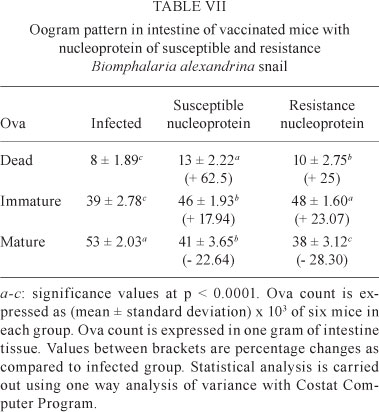Despite effective chemotherapy, schistosomiasis remains the second largest public health problem in the developing world. Currently, vaccination is the new strategy for schistosomiasis control. The presence of common antigenic fractions between Schistosoma mansoni and its intermediate host provides a source for the preparation of a proper vaccine. The objective of this paper is to evaluate the nucleoprotein extracted from either susceptible or resistant snails to protect against schistosomiasis. The vaccination schedule consisted of a subcutaneous injection of 50 µg protein of each antigen followed by another inoculation 15 days later. Analyses of marker enzymes for different cell organelles [succinate dehydrogenase, lactate dehydrogenase (LDH), glucose-6-phosphatase, acid phosphatase and 5'-nucleotidase] were carried out. Energetic parameters (ATP, ADP, AMP, phosphate potentials, inorganic phosphate, amino acids and LDH isoenzymes) were also investigated. The work was extended to record worm and ova counts, oogram determination in the liver and intestine and the histopathological pattern of the liver. The nucleoprotein of susceptible snails showed reduction in worm and ova counts by 70.96% and 51.31%, respectively, whereas the nucleoprotein of resistant snails showed reductions of 9.67% and 16.77%, respectively. In conclusion, we found that the nucleoprotein of susceptible snails was more effective in protecting against schistosomiasis.
Biomphalaria alexandrina; susceptible; resistant; Schistosoma mansoni; vaccine; nucleoprotein













